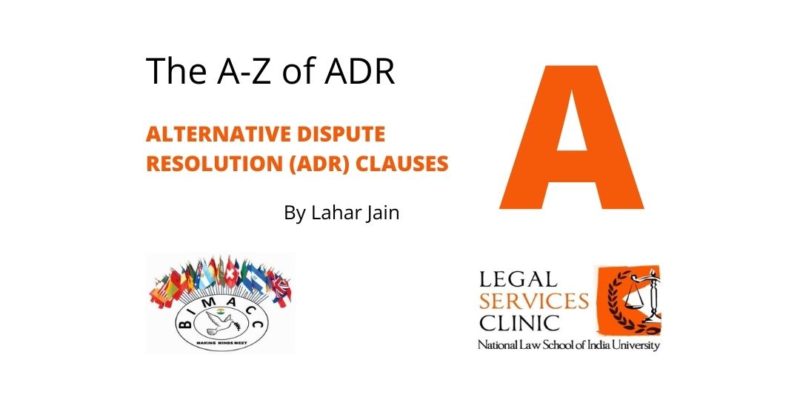
A-Z of ADR: Alternative Dispute Resolution (ADR) Clauses by Lahar Jain
-Lahar Jain (II Year, NLSIU Bangalore)
The inclusion of Alternative Dispute Resolution (ADR) clauses in most agreements in a globalised market is hardly discordant due to the increasing popularity of such mechanisms. However, most arbitration disputes deal with contentions involving such clauses and this is the reason that the phraseology, purpose and position of these clauses are of utmost importance. I will begin by highlighting the importance of explicitly providing for such a clause and then move onto a brief overview of the types of ADR clauses, along with their significance in law. Lastly, I will deal with the drafting of such clauses, while also providing a model clause along with the common mistakes made while drafting these.
Why must you provide for an ADR clause in an agreement?
A breach in a contract opens a can of worms to the plethora of redressal mechanisms available to you. Litigation, while being a popular means of redressal, has a range of drawbacks including high costs, time-consuming, lack of confidentiality and flexibility. An ADR clause allows you to resolve the dispute outside of the standard litigation process. It overcomes most of the shortcomings of litigation while keeping party autonomy at the highest pedestal.
ADR clauses streamline the redressal process to exclude any uncertainty and explicitly provide for the means of settling the dispute. These clauses contain the scope of the issues dealt with under the ADR mechanism, the process of filing and replying to contentions and finally, the process of dispute resolution. One can also choose the language, number of arbitrators and the place for resolving such a dispute. Hence, providing for an ADR clause in contracts is highly beneficial to both parties
Types of ADR clauses:
It is important to highlight that an alternative redressal can also take place without explicitly mentioning it in the contract, and this is termed as an ad hoc redressal mechanism. This can happen when both parties agree to distance themselves from litigation after a breach and mutually agree upon the form of dispute settlement.
However, explicitly providing for a clause at the time of the formation of the contract leads to much less ambiguity about the procedural elements of the dispute. There are various types of redressal mechanisms, where parties can pick and provide for in the contracts, depending upon their suitability and feasibility.
First, we deal with a simple ADR clause. Most parties provide for an arbitration clause in contracts. Arbitration is a process where the dispute is addressed by arbitrators experienced in commercial matters, picked by the parties and their decision is binding upon them. An arbitration clause submits all or some specific disputes which arise out of the contract over to arbitration. This is important since there are some types of disputes that inherently cannot be arbitrated upon. They agree not to litigate the matter and approach a third party institution or arbitrator to settle the dispute. When the parties agree to be bound by the rules of an institution, such as the LCIA, SIAC, or BIMACC and allow it to administer the process, this is termed as an institutional arbitration.
It is important to note that an arbitration clause in an agreement forms a separate agreement by itself. This is called the principle of severability. This means that even if the agreement is void and a dispute on this voidness arises, the arbitration clause survives, as long as it is validly drafted, and the parties can approach an arbitral tribunal. The essential requirements of such a valid clause and common mistake while drafting will be dealt with in the next section.
Second, we address the relevance of a multi-tiered dispute resolution clause. They are also known as escalation clauses or filter clauses.[1] It provides for an alternative redressal mechanism at every step and finally flows into arbitration. These escalation clauses most commonly provide for means to settle the dispute amicably, and then the commencement of the arbitration.
The amicable forms of settling the dispute can be varied. They range from mandating mediation (Med-Arb clause) and/or conciliation and/or negotiation before the parties can arbitrate. In the case of Simpark Infrastructure Pvt. Ltd. v. Jaipur Municipal Corporation,[2] the court held that when an agreement explicitly provides for following this escalated procedure, the parties are bound by it before invoking the arbitration clause under S.11 of the Arbitration and Conciliation Act, 1996. Another example of this customisable arrangement can be of Arb-Med-Arb clauses, wherein the parties invoke arbitration and then move into mediation to hopefully resolve the dispute, which is finally enforced by another arbitral tribunal. However, all of these clauses must have a ‘trigger’ specifying the timeline and circumstances after which arbitration can be invoked.
Drafting of an arbitration agreement and a model clause:
An arbitration clause consists of various elements, including the seat of arbitration, the scope of the clause, the forum selected, choice of venue, governing law, number of arbitrators, the language of the arbitration and the choice of an institute. The exclusion of one or more elements from the agreement will lead to ambiguity, where the tribunal or courts will have to interpret and decide the matter. Hence, it is strongly encouraged to explicitly provide for all these factors in the clause.
The different institutional arbitration centres have different model clauses, most of which are modelled along the same lines. The Singapore International Arbitration Centre (SIAC) provides for one such model clause as follows:[3]
“Any Dispute arising out of or in connection with this contract, including any question regarding its existence, validity or termination, shall be referred to and finally resolved by arbitration administered by the ______________(an institute) in accordance with the __________ (procedural rules) for the time being in force, which rules are deemed to be incorporated by reference in this clause.
The seat of the arbitration shall be __________.
The Tribunal shall consist of ________ arbitrator(s).
The language of the arbitration shall be __________.
The governing law
shall be ____________.”
[1] Manish Lakhawat, ‘Multi-Tier Arbitration Clauses: Directory or Mandatory?’ (22 June 2018) < https://www.mondaq.com/india/arbitration-dispute-resolution/712978/multi-tier-arbitration-clauses-directory-or-mandatory> accessed 1 August 2020.
[2] Simpark Infrastructure Pvt. Ltd. v. Jaipur Municipal Corporation MANU/RH/1010/2012.
[3] Singapore International Arbitration Centre (SIAC) < https://www.siac.org.sg/model-clauses/siac-model-clause> accessed 1 August 2020.
-Lahar Jain (II Year, NLSIU Bangalore)
Lahar Jain is a second-year student from the National Law School of India University (NLSIU), Bangalore.
BIMACC expresses its gratitude towards the author and to the members of the Legal Services Clinic, National Law School of India University (NLSIU) for their support in our collaborative efforts to promote ADR with this series titled “A-Z of ADR”. The purpose of this series is to increase the understanding of certain fundamental concepts of Alternative Dispute Resolution.
The Legal Services Clinic is a student-run committee that provides free legal services to the socially and the economically backward sections of the society who have difficulty accessing the judicial system. It also has a mandate of spreading legal awareness and providing free legal assistance to those who cannot afford it.
Website: www.legalservicesclinic.org/
Facebook: @legalservicesclinic
Email: lsc.nlsiu@gmail.com
Phone Number: 073586 73214
Disclaimer: The views and opinions expressed in this blog are those of the author and do not necessarily reflect the official policy or position of BIMACC, any of the members of the Board, or the empanelled neutrals. This blog is for informative purpose only and does not constitute legal advice in any manner whatsoever.
